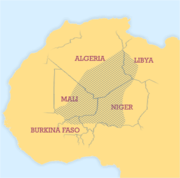| map from nationsonline.org |
The people of Africa also grew, produced dye, traded, and decorated their garments with indigo. Unlike China and France, consisting of large established groups of working people, Africa was a continent of diverse tribal people. For example the Touareg people inhabited the Sahara desert shown by the shaded area on the map below. Later this area was divided into the African countries also shown on the map. The Touareg, a nomadic people were thought to be influenced by Arabs and demonstrated by the practice of wearing of veils. Unlike Arab women who wear veils it is the Touareg men not the women covered their faces with indigo turbans.


Saraha Desert (both images from Wikipedia) Touareg man from Algeria
The Touareg men of the Sahara were known as "blue men" because of their indigo turbans called tagelmousts. The turban was thought to protect them from evil spirits. On a practical note the turbans also protected them from the desert heat and blowing sand.
The other blue men, who wearing indigo garments, were the Moorish camel traders of Morocco and Mauritania who still don their indigo turbans and robes for festivals. Even in the 17th century indigo dyed garments were quite costly and considered a status symbol. The deeper the blue or the more indigo dye that was used in the dying process also reflected the status of the wearer.
Indigo blue was known as the national color of Africa. As the production of indigo and the desire to have indigo garments grew, each culture incorporated their own style and decorative techniques to produce unique indigo textiles and clothing.
No comments:
Post a Comment